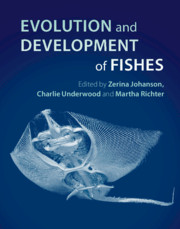Book contents
- Evolution and Development of Fishes
- Evolution and Development of Fishes
- Copyright page
- Contents
- Contributors
- Introduction
- 1 The Evolution of Fishes through Geological Time
- 2 Comparative Development of Cyclostomes
- 3 The Ordovician Enigma
- 4 The Evolution of Vertebrate Dermal Jaw Bones in the Light of Maxillate Placoderms
- 5 Doliodus and Pucapampellids
- 6 The Evolution of Endoskeletal Mineralisation in Chondrichthyan Fish
- 7 Plasticity and Variation of Skeletal Cells and Tissues and the Evolutionary Development of Actinopterygian Fishes
- 8 Origin, Development and Evolution of the Fish Skull
- 9 Evolution, Development and Regeneration of Fish Dentitions
- 10 Development of Head Muscles in Fishes and Notes on Phylogeny-Ontogeny Links
- 11 Evolutionary Development of the Postcranial and Appendicular Skeleton in Fishes
- 12 Evolution of Vertebrate Reproduction
- 13 Links between Thyroid Hormone Alterations and Developmental Changes in the Evolution of the Weberian Apparatus
- 14 Pharyngeal Remodelling in Vertebrate Evolution
- 15 Evolution of Air Breathing and Lung Distribution among Fossil Fishes
- Index
- References
6 - The Evolution of Endoskeletal Mineralisation in Chondrichthyan Fish
Development, Cells and Molecules
Published online by Cambridge University Press: 31 December 2018
- Evolution and Development of Fishes
- Evolution and Development of Fishes
- Copyright page
- Contents
- Contributors
- Introduction
- 1 The Evolution of Fishes through Geological Time
- 2 Comparative Development of Cyclostomes
- 3 The Ordovician Enigma
- 4 The Evolution of Vertebrate Dermal Jaw Bones in the Light of Maxillate Placoderms
- 5 Doliodus and Pucapampellids
- 6 The Evolution of Endoskeletal Mineralisation in Chondrichthyan Fish
- 7 Plasticity and Variation of Skeletal Cells and Tissues and the Evolutionary Development of Actinopterygian Fishes
- 8 Origin, Development and Evolution of the Fish Skull
- 9 Evolution, Development and Regeneration of Fish Dentitions
- 10 Development of Head Muscles in Fishes and Notes on Phylogeny-Ontogeny Links
- 11 Evolutionary Development of the Postcranial and Appendicular Skeleton in Fishes
- 12 Evolution of Vertebrate Reproduction
- 13 Links between Thyroid Hormone Alterations and Developmental Changes in the Evolution of the Weberian Apparatus
- 14 Pharyngeal Remodelling in Vertebrate Evolution
- 15 Evolution of Air Breathing and Lung Distribution among Fossil Fishes
- Index
- References
Summary
Chondrichthyan fishes possess an endoskeleton made exclusively of cartilage. Their cartilaginous tissue is very similar in terms of cell types, the extracellular matrix and embryonic origins to the cartilage of other jawed vertebrates. In bony fish however, most of the embryonic cartilaginous endoskeleton degrades and is replaced by a skeleton made of endochondral bone often associated with dermal bone. Paleontological data support the view that the chondrichthyan cartilaginous skeleton is evolutionarily associated with a secondary loss of dermal bone (ancestral to jawed vertebrates), while endochondral bone has evolved within the bony fish lineage. A synapomorphy of the chondrichthyan skeleton is the development of a superficial layer of small, mineralised cartilage units covering the endoskeleton, known as ‘tesserae’. Less well described are two other sites of skeletal mineralisation, namely the vertebral centrum that is composed of a mineralised layer surrounding the notochord (herein described as fibrous mineralisation) and only found in selachians, and a mineralised layer surrounding the neural arches (herein described as lamellar mineralisation) that is only well known in Carchariniformes. Embryonic series of histologically stained sections of the skeleton of two selachians (a shark Scyliorhinus canicula, a skate Raja clavata) and new comparable data from an holocephalan Hydrolagus sp. allows cell and extracellular matrix comparisons of developing skeletons in Chondrichthyes. Various cell types might be involved in this developmental process. A review is provided of molecular data already published and the new genomic and transcriptomic tools that highlight current trends in the study of skeletal evolution of cartilaginous fish. These new techniques point to the presence of genetic networks that led to the evolution of various cell populations involved in skeletal mineralisation and chondrichthyan diversification.
- Type
- Chapter
- Information
- Evolution and Development of Fishes , pp. 110 - 125Publisher: Cambridge University PressPrint publication year: 2019
References
- 5
- Cited by

